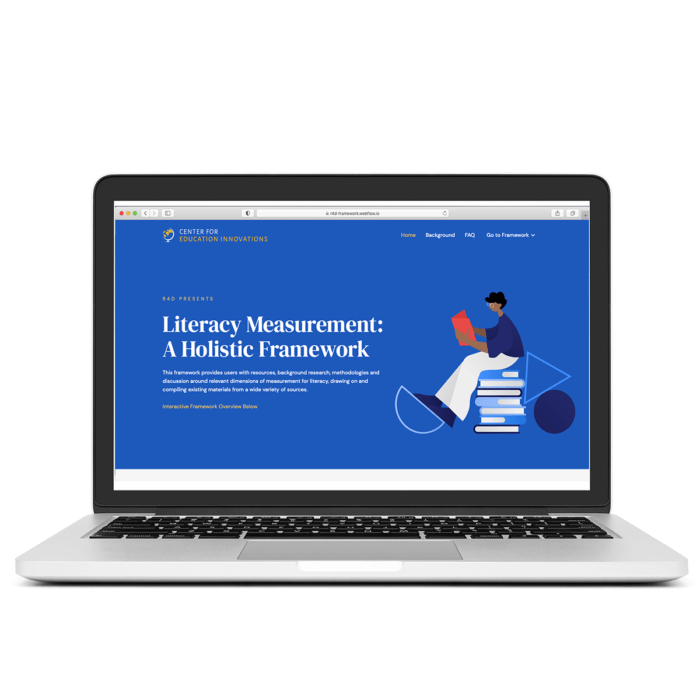Tools and resources we created with 100+ literacy practitioners
Two years ago, our team at R4D’s Center for Education Innovations began working with Pearson’s Project Literacy campaign to tap into the knowledge and experiences of literacy practitioners around the world. We wanted to better understand the gaps in the literacy sector, the common challenges that literacy programs face, and how we might tap into the shared experiences of literacy implementers, funders, and researchers to accelerate the spread of literacy.
Since then, we’ve spoken with and facilitated collaboration between more than 100 literacy practitioners from more than 20 countries through consultations, advisory committees, and a virtual community of practice. As a result, we and our partners have turned the collective discussions, guidance, experiences into resources and tools to address the shared challenges encountered in literacy programs.
Today, we are excited to launch the second in the series of tools — Literacy Measurement: A Holistic Framework. The framework includes guidance and resources around traditional measures of literacy assessment, such as reading fluency and vocabulary, but it also advocates for a holistic approach considering other, potentially difficult to measure, but equally important dimensions. The framework includes non-traditional literacy outcomes dimensions like developing reading habits and a love of reading, and places equal weight on program performance measures. It also emphasizes equity and context considerations.
What is the framework and who is it for?
The framework is an interactive, easy-to-use tool designed to help implementers and evaluators of literacy programs think about their programs and measurement more holistically. Whether you are designing a new measurement strategy from scratch or just looking to enhance your current thinking, the framework provides a wealth of evidence-backed guidance and resources to help you develop a measurement strategy that is most relevant to the age groups, literacy levels and geographic contexts you serve. Many of our partners work in resource-constrained environments, so we’ve tuned the framework to be particularly useful for individuals at small and medium-sized organizations with limited monitoring and evaluation resources.

A look inside…
The framework groups dimensions around measuring program performance and measuring literacy outcomes. It also contains a third section with measurement how to’s for those new to designing measurement strategies.
Each dimension contains a brief overview with special considerations and a wealth of resources, including academic papers, toolkits, practical guides, program evaluations and relevant websites. Framing questions also accompany every dimension to help users apply resources within their unique contexts.

Why is it important?
When we first started exploring the need for a literacy measurement framework, we conducted a listening tour with literacy measurement experts from 18 different organizations. During these conversations, we heard:
- A desire for more comparability and standardization of literacy measurement practices, while accounting for the uniqueness of contexts and languages within which literacy programs operate.
- An interest in expanding the definition of literacy beyond literacy skills to include measures for progress in establishing behaviors and supportive environments that enable reading and writing.
- An increasing concern around equity in literacy assessment — who assessments are designed for and who is included in measurement exercises.
- A need for more guidance and resources beyond early grade literacy measurement. While many tools are available for early grade literacy assessment, few are easily accessible for assessing pre-literacy skills and the literacy of older children, youth, and adults.
We created Literacy Measurement: A Holistic Framework as a response to these needs and as an effort to expand collaboration and conversation within the literacy community around approaches to measurement. The framework was developed in close consultation with advisors from the Australian Council for Educational Research (ACER), Room to Read, People’s Action for Learning Network (PAL Network), and ProLiteracy — organizations working in literacy program assessment and implementation from early grades to adult literacy.
A number of organizations — including the Global Alliance to Monitor Learning (GAML), the UNESCO Institute of Statistics (UIS) and the Australian Council on Education Research — have already or are currently developing methodologies and mechanisms for comparing the results of different assessment methodologies. This framework is complementary to these efforts, providing more flexible guidance for developing context-specific measurement strategies for literacy programs, but not focused on ensuring international comparability.
We want this to be a living resource, so we encourage and welcome resource contributions through the online form to help us create an even more robust resource base for literacy measurement practitioners.
Through the collective knowledge of many, we hope Literacy Measurement: A Holistic Framework helps you start or continue to think about how we create and measure well-rounded literacy programs.
Literacy Measurement: A Holistic Framework is the second in a series of tools developed in close collaboration with literacy practitioners around the world. The first of these tools — the Storytelling Roadmap — was published earlier this year and designed to help literacy practitioners more effectively advocate for their work. Keep an eye out for additional tools launching over the next two months.
Catch up on the series:
- “Tools and resources we created with 100+ literacy practitioners”
- “A practical tool to increase parent engagement in children’s literacy”
- “A teacher’s one-stop shop for localized literacy tools”














